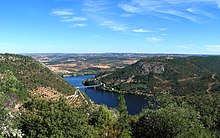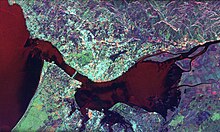
A | B | C | D | E | F | G | H | CH | I | J | K | L | M | N | O | P | Q | R | S | T | U | V | W | X | Y | Z | 0 | 1 | 2 | 3 | 4 | 5 | 6 | 7 | 8 | 9
You can help expand this article with text translated from the corresponding article in Spanish. (April 2009) Click for important translation instructions.
|
| Tagus | |
|---|---|
 View of Tagus River in Toledo, Spain | |
 Path of the Tagus through the Iberian Peninsula | |
| Etymology | Vulgar Latin taliāre, "to cut through" |
| Location | |
| Country | Spain, Portugal |
| Physical characteristics | |
| Source | Fuente de García, Montes Universales |
| • location | Frías de Albarracín, Spain |
| • coordinates | 40°19′16″N 1°41′49″W / 40.321°N 1.697°W |
| • elevation | 1,593 m (5,226 ft) |
| Mouth | Estuary of the Tagus, Atlantic Ocean |
• location | Lisbon, Portugal |
• coordinates | 38°41′28″N 9°10′16″W / 38.691°N 9.171°W |
• elevation | 0 m (0 ft) |
| Length | 1,007 km (626 mi) |
| Basin size | 80,100 km2 (30,900 sq mi) |
| Discharge | |
| • average | 500 m3/s (18,000 cu ft/s) |
| Basin features | |
| Tributaries | |
| • left | Guadiela, Algodor, Gévalo, Ibor, Almonte, Salor, Sever |
| • right | Gallo, Jarama, Guadarrama, Alberche, Tiétar, Alagón, Zêzere |


The Tagus (/ˈteɪɡəs/ TAY-gəs; Spanish: Tajo [ˈtaxo]; Portuguese: Tejo [ˈtɛʒu]; see below) is the longest river in the Iberian Peninsula. The river rises in the Montes Universales near Teruel, in mid-eastern Spain, flows 1,007 km (626 mi), generally westward, and empties into the Atlantic Ocean in Lisbon.[1]
Nameedit
The river's Latin name is Tagus. While the etymology is unclear, the most probable etymological origin for the hydronym Tagus is Indo-European *(s)tag- ('to drip').[2]
Geologyedit
The lower Tagus region in Portugal is a seismically active area. Major earthquakes in the Lower Tagus include those of 1309, 1531, and 1909.[3][4]
Inverted Deltaedit

Tagus river is one of the few rivers in the world to have an inverted delta. Its delta is wider at the beginning and narrows down as it approaches the sea, contrary to a typical delta. This is because it flows into the sea through a small opening in a valley. Although due to sedimentation, this delta is now only very partially inverted, with the valley now mostly filled with sediment. The delta is about 15 km wide and 25 km long, but its exit into the sea is only 2 km wide. It thus forms a large lagoon with large and very shallow sand banks which go uncovered during low tides. The delta used to be even bigger thousands of years ago.
Historyedit

The Pepper Wreck, properly the wreck of the Nossa Senhora dos Mártires, is a shipwreck located and excavated at the mouth of the Tagus between 1996 and 2001.[5]
The Tagus river basin comprises 42 River Nature Reserves [es] and is the river basin with the most protected areas in Spain.[1]: Prefacio
See alsoedit
- List of rivers of Spain
- List of rivers of Portugal
 Media related to Tagus River at Wikimedia Commons
Media related to Tagus River at Wikimedia Commons
Referencesedit
- ^ a b Riera Aragay, Ana; Sánchez, Javier (15 March 2023) 2022:GeoPlaneta. Guía de las Reservas Naturales Fluviales de la cuenca del Tajo [Guía de las Reservas Naturales Fluviales de la cuenca del Tajo]. Madrid: GeoPlaneta. ISBN 9788408268888. OCLC 1376251354.
- ^ Curchin, Leonard A. (2007). "Toponyms of Lusitania: a re-assessment of their origins" (PDF). Conímbriga. XLVI: 151. doi:10.14195/1647-8657_46_7.
- ^ Hobbs, William Herbert (1907). Earthquakes: An Introduction to Seismic Geology. New York: D. Appleton and Company. pp. 142–144. Downloadable Internet Archive
- ^ "Sismo sentido em Lisboa na mesma zona dos grandes abalos de 1531 e 1909" [Earthquake felt in Lisbon in the same area as the great earthquakes of 1531 and 1909] (in Portuguese). Diário de Notícias. 18 March 2021. Retrieved 29 October 2021.
- ^ Vieira de Castro, Filipe (2005). "6". The Pepper Wreck: A Portuguese Indiaman at the Mouth of the Tagus River. Ed Rachal Foundation nautical archaeology series. College Station: Texas A&M University Press. p. 87, 97, 100. ISBN 9781585443901. OCLC 56517607.
Text je dostupný za podmienok Creative Commons Attribution/Share-Alike License 3.0 Unported; prípadne za ďalších podmienok. Podrobnejšie informácie nájdete na stránke Podmienky použitia.
Antropológia
Aplikované vedy
Bibliometria
Dejiny vedy
Encyklopédie
Filozofia vedy
Forenzné vedy
Humanitné vedy
Knižničná veda
Kryogenika
Kryptológia
Kulturológia
Literárna veda
Medzidisciplinárne oblasti
Metódy kvantitatívnej analýzy
Metavedy
Metodika
Text je dostupný za podmienok Creative
Commons Attribution/Share-Alike License 3.0 Unported; prípadne za ďalších
podmienok.
Podrobnejšie informácie nájdete na stránke Podmienky
použitia.
www.astronomia.sk | www.biologia.sk | www.botanika.sk | www.dejiny.sk | www.economy.sk | www.elektrotechnika.sk | www.estetika.sk | www.farmakologia.sk | www.filozofia.sk | Fyzika | www.futurologia.sk | www.genetika.sk | www.chemia.sk | www.lingvistika.sk | www.politologia.sk | www.psychologia.sk | www.sexuologia.sk | www.sociologia.sk | www.veda.sk I www.zoologia.sk
